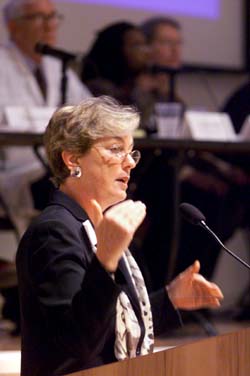
Lee Limbird, Ph.D, speaks at the NIH compliance meeting held for Vanderbilt faculty and staff in the Wyatt Center.(photo by Dana Johnson)
NIH visits Vanderbilt to gauge compliance
When a baseball player hits the ball out of the park, it looks like a home run. But the player must first touch all of the bases in order, thereby complying with the rules and regulations of baseball. Without compliance, there’s no home run.
The message holds for research as well, said Gary Thompson, director of the division of Grants Compliance and Oversight at the National Institutes of Health, on the second day of the recent NIH Proactive Compliance Site Visit. When it comes to research rules and regulations, the risks of non-compliance are high, he said, citing the $15.9 billion NIH budget-81 percent of which goes outside the NIH in the form of grants and contracts.
“We are stewards of these federal funds,” he said, “and we must properly safeguard this investment in biomedical research.”
Thompson was the head of the NIH site visit team that visited 10 academic institutions over the past six months as part of an effort to learn national mechanisms for implementing research compliance. The Vanderbilt site visit was the team’s last.
“The purpose of these site visits has been to assess the level of understanding of certain NIH rules by discussing policies, procedures, and practices at recipient institutions to ensure compliance with NIH requirements,” Thompson said. “Our objective is to move from ‘reactive non-compliance’ to ‘proactive compliance.’”
Day one of the visit included small group discussions of NIH rules and institutional compliance practices, exploring how Vanderbilt specifically undertakes its research compliance efforts. On the second day, a panel of NIH site visit team members and Vanderbilt leaders made presentations and invited discussion from a group of faculty and staff engaged in research.
Vanderbilt leaders emphasized the institution’s engagement in ensuring compliance.
“The commitment of faculty and staff in creating a culture of compliance at Vanderbilt is unquestioned,” said Provost Thomas G. Burish, Ph.D.
“As the Medical Center and University Central collaborate more and more in research, we will move toward a more concerted effort in compliance,” said Dr. Harry R. Jacobson, vice chancellor for Health Affairs. “A centralized approach to compliance is still evolving.”
Discussions during the second day’s sessions included: compliance and oversight; financial management of sponsored projects; intellectual property developed from extramurally funded research; invention reporting policy and procedures; data and safety monitoring of clinical trials; administration/science partnership; and financial conflict of interest.
Vanderbilt leaders in the research enterprise, led by Lee E. Limbird, Ph.D., associate vice chancellor for Research, described compliance practices at Vanderbilt, focusing on how roles and responsibilities are articulated and the mechanisms for training faculty, trainees, and staff involved in research about compliance issues.
Efforts in developing online training opportunities were highlighted. The Vanderbilt compliance Web site is: www.vanderbilt.edu/compliance/html/frame_trcp.htm.
The mutual exchange of information during the site visit was productive.
“Our sessions yesterday went very well,” Thompson said. “What we have learned during our visit speaks well of the culture here – there’s a great climate for doing research.”
“This visit has been of considerable value to Vanderbilt,” Limbird said in thanking the NIH team. “We were on track with a program to address compliance issues and your visit certainly accelerated our progress.”
Vanderbilt compliance officers are Menah A. E. Pratt, J.D., Ph.D. for University Central and Dr. James D. Snell Jr., professor of Medicine for the Medical Center.
Other universities selected for Proactive Compliance Site Visits included Johns Hopkins University, University of Texas Southwestern Medical Center at Dallas, University of California San Francisco, Harvard University, Medical University of South Carolina, University of Miami, Indiana University, and Oregon Health Sciences University. The NIH team will now compile its findings and make national recommendations for implementation policies covering research compliance. n













